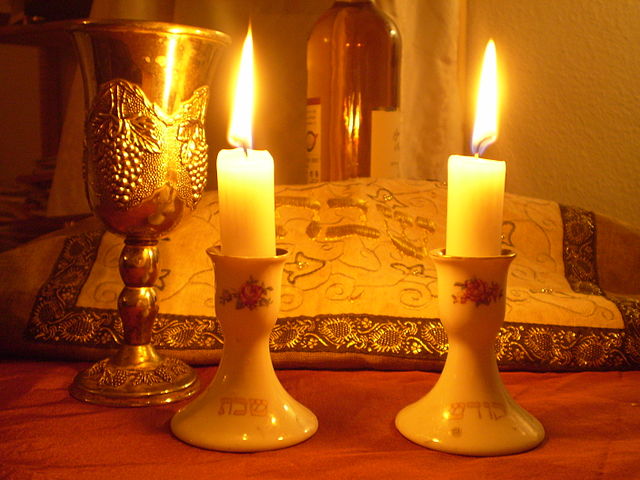Jesus was going to the house of a very high-status Pharisee to have a Sabbath meal. The Sabbath was a required tradition, with lots of things that you could and could not do on the Sabbath. There was no work allowed, human or animal, although the animal must be fed before you yourself ate. If a person wanted to go to the synagogue on the Sabbath, either after sundown on Sabbath eve or on the Sabbath itself on Saturday, they must walk. Meals were prepared before sundown, and to have someone invited to share your Sabbath dinner meant considerable work must take place before dark.
Jesus knew that the Pharisees were keeping a very sharp eye on him, but yet, in front of him, appeared a man with dropsy. Dropsy was the word for people with edema, swelling of tissues caused by water retention. It was painful and could be life-threatening. Knowing that he would be severely questioned and possibly worse for breaking the Sabbath prohibition on work, Jesus turned the tables and asked the Pharisees and the lawyers if it was legal or lawful to cure people on the Sabbath. People often asked the Pharisees questions since they were the ones who clarified the law, yet this man, a Nazarene, was asking them something them they weren’t sure how to answer. Jesus healed the man and sent him on his way. Then he turned to the group and said words to the effect that if they had a child or an ox that fell in a well on the Sabbath, wouldn’t they immediately go and pull them out even if it meant work on the Sabbath? The gospel notes that the Pharisees and lawyers said nothing.
Just a week or so ago, an angry man went into a synagogue on a Saturday morning and began shooting people peacefully carrying out their Sabbath duty to gather, pray, and learn. The angry man’s motive was hatred of the people in the synagogue, simply because they were Jewish. Eleven people died within a very few minutes, three police officers were shot, and the gunman also received multiple wounds from police fire. It was a terrible, gut-wrenching tragedy. Yet, while we try to comprehend it all, we remember the story of the Jewish nurse, himself concerned about the safety of his parents at the synagogue, who treated the gunman who had taken so many lives with kindness and respect, despite the man’s antisemitic statements and the knowledge of how far that hatred had gone. Still, we remember the example of the nurse who cared with compassion and love a man who hated him and his people.
We have Pharisees among us, people who watch us to see where we have faults and where we don’t follow the law according to their interpretations of it. We also have a model that we are urged to emulate, the man Jesus, who preached love and compassion rather than legalism and often shallow piety.
Now we have another shooting, this time in Thousand Oaks, California, where the targets seemed to be young college students out having an enjoyable evening with their friends. In between the two events are other shootings, random and targeted killings, and suggestions for us to carry more guns to prevent more murders by gunfire. It’s hard to think of a church or synagogue, a place of peace and worship, as being needful of armed guards inside to protect it. Just as at the shooting at the AME church in Charleston, South Carolina in 2015, my question is whether a place dedicated to the Prince of Peace be somewhere where a militia or guards should be placed to protect that peace? What would Jesus do?
But we have forgotten the man with dropsy. Maybe he didn’t realize the place into which he was putting himself – between two people or groups of people who saw things differently and not in an amicable way. The man just went to Jesus to ask for healing, whether it was on the Sabbath or not. Pain and danger don’t seem to keep to the calendar marked with sacred days. Today a person would go to a doctor or clinic, no matter what day it was, and expect to be healed, or, at least, be given a prescription that would make them better in a short period. They would expect to be treated with respect, kindness, and compassion, no matter how cranky or crabby they were, and despite how overworked, tired, sad, or frustrated the nursing staff and doctors were at the time. How frustrated might the Jewish nurse and doctor have been on that Sabbath morning of the shooting? Yet they did their best and treated the patient they had on the table in front of them.
I think it’s a lesson that I can certainly learn from. Had these medical workers been Christian, we would be declaring them prime examples of how Jesus taught us to be and do. We forget that Christians and Jews share a good many things and teachings since Christianity grew out of Judaism – with an itinerant Jewish preacher, teacher, and healer.
May we all have a peaceful and blessed Sabbath, a Shabbat shalom.
G-d bless.
Image: Shabbat Candles, by Olaf.herfurth – Own work. Found at Wikimedia Commons.
Linda Ryan is a co-mentor for an Education for Ministry group, an avid reader, lover of Baroque and Renaissance music, and -retired. She keeps the blog Jericho’s Daughter. She is also owned by three cats.

